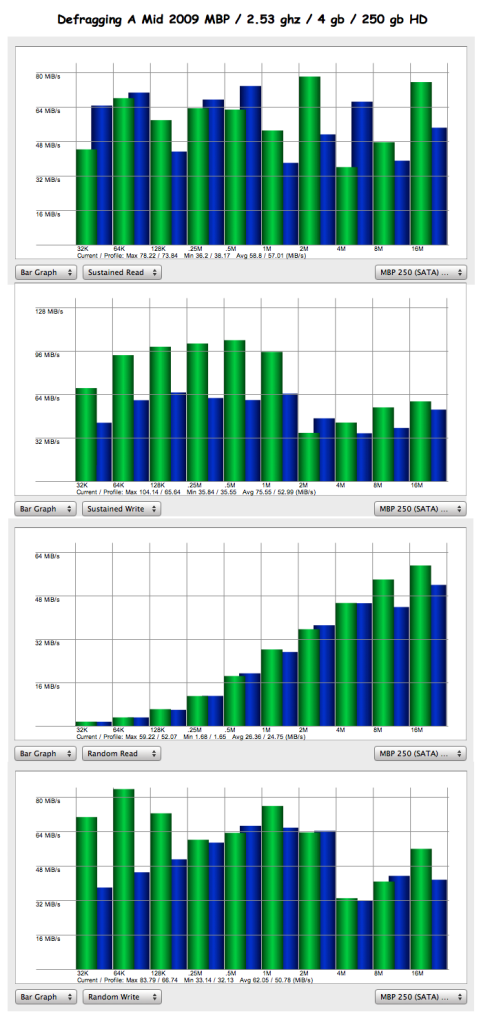Stanley,
Can you explain what I am looking at ?
I understand the " before " and " after " thing , but what I don't understand is WHAT " before " and WHAT " after "
Cheers ... McBie
An unfragmented drive runs faster and quieter than one which has split up many files. New computers come to you in good shape fragmentation-wise. After awhile some computers slow down a bit. This is often unnoticeable on Macs. It is not a big problem.
A bit hard to go over it all in a scrolling message board…you might want to track down some hard drive test comparisons if my effort in this post falls short.
The 1st graph shows sustained reading speed. This is getting data from the hard drive, large files like video, starting up the Mac etc. The 2nd graph shows the same idea, but for writing files to the hard drive. These files are pretty much all in one spot on the drive and it is just pushing out or accepting data.
The next two graphs show reading and writing of files in a random manner..spread out across the drive, fragmented files etc.
Green is after the hard drive was defragmented. This means that, say, a movie file that was once in 500 pieces spread out all over a drive is put back together. A book is all in one place…what if one page was in the kitchen…another on the bed, another in the garage, more blowing around outside in the wind. By having things in one place, the hard drive is faster and works less hard. Blue is before the drive was defrayed.
The file sizes across the x axis show that the rate of data transfer (in or out depending on which graph) varies according to size.
In general, you can see that green is higher in many zones and this means files open faster and can be saved faster.
I'm sure I did not do the best possible job here…corrections are welcome, or you can do some research if you'd like.
I did this test since so many folks repeat that Mac don't need defragmenting etc. Well they do benefit. This particular computer was never serviced or defragged since Summer 2009 and is a workhorse. A windows computer would not be in such decent shape, nor take so little time to tune back up.
When you do a fresh install of OSX onto a just formatted drive it will be unfragmented for the most part. If you then install your Apps and data from backup drive(s), then they should be more or less in one place too when the transfer is done. Apple has certain zones on a drive that are hot spots or preferred areas, many of the files can benefit from this. This is part of why many on this board like fresh installs. So does Apple (= their way of defragging to an extent). But if you upgrade to Lion as I did, (just let it rip, right over the old OS) you will have some fragmenting. It was pretty easy to get done in this manner. Out of a million something files, 700,000+ were in pieces on my drive. HDs are very peppy so this is not as bad as you think. It's like you had a super helped at home finding each separate page of a book as you read it.
One thing I noted is that for the software I used, it liked being on a separate drive. Onto that drive I installed Snow Leopard so that I could boot from that drive. And the drive software too. This also allows me to go to other Macs and spritz them up by just plugging into the FW800 port. The external drive needed to be Mac formatted and also have the ~EUID option chosen when I partitioned it. Without EUID you cannot boot from an external drive. That one had me stymied for awhile as I could not boot at first until I redid it. I noticed in the customer comments for the drive in the store's review section that some had said the drive was no good for Macs since he could not get it to boot properly. I suspect that the EUID thing was the issue there. It was all in the tech material I didn't read! ;-)






